The shapes of surfaces captured the imagination and attention of many mathematicians in the 19th century. To unfold the visual secrets compressed and hidden within the shorthand of algebraic expressions, geometers drew pictures, constructed models, and wrote manuals on how to visualize mathematical forms. Some even commissioned artisans to fashion wooden, plaster, and wire versions of these abstract figures.
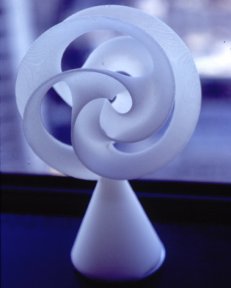

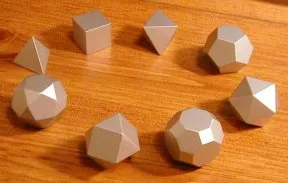
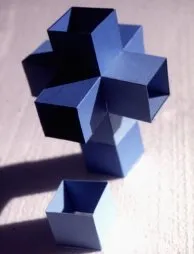
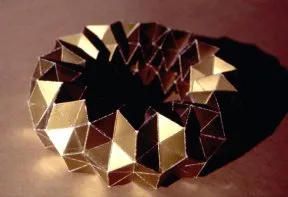



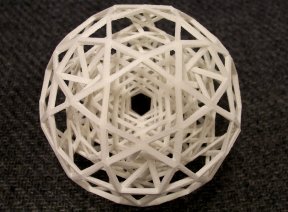
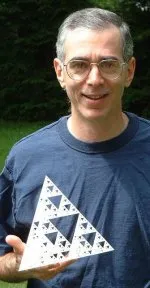
These models and drawings brought together the logically abstract and the visually concrete in mathematics. They were not only a source of pleasure but also a valuable tool for teaching and for probing a slew of exotic geometric structures.
In recent times, mathematicians have demonstrated the usefulness of computer graphics for visualizing geometric forms. With a remarkable ability to convert equations into colorful, evocative images on a screen, computers now play an important role in communicating ideas, discovering patterns, and suggesting new conjectures worth testing.
Standard computer graphics by itself, however, doesn’t do justice to three-dimensional forms. Fortunately, new technologies have made it possible to create 3D models of geometric shapes, magically transforming equations into elegant, intriguing miniatures.
“Many mathematicians consider models valuable for building intuition and for communicating mathematical ideas to students and to the public,” George W. Hart of SUNY at Stony Brook writes in the current issue of the Mathematical Intelligencer. “Nothing can substitute for the visual and tactile pleasure of handling a model, spinning it in one’s hand, comparing it to another model in the other hand.”
“With the right equipment,” he adds, “one can create and enjoy a mathematical museum collection without leaving one’s office.”
To make miniature physical models of diverse polyhedra and 3D fractal structures such as the Menger sponge or Sierpinski tetrahedron, Hart takes advantage of “solid freeform fabrication” (SFF) technologies (see http://www.georgehart.com/rp/rp.html).
Also known as rapid-prototyping fabrication processes, these technologies, in essence, convert a design, expressed in a suitable language, into an accurate, compact model of a structure by building it up layer by thin layer.
In one such 3D-printing process, a high-powered, computer-controlled laser fuses nylon dust in places where the designer wants solidity. The dust left in the voids can be vacuumed away later, leaving the model, in all its intricacy, intact.
Hart, computer scientist Carlo Séquin of the University of California, Berkeley, artist Bathsheba Grossman of Santa Cruz, Calif., and others have used SFF technologies to create a wide variety of mathematical mini-sculptures.
Grossman, for example, has produced pocket-sized, fused-metal models of such geometric objects as the 120-cell and the gyroid (see http://www.bathsheba.com/math/). Such models, when made out of wax, resin-impregnated starch, or plastic, also allow her to use the ancient lost-wax method to cast imaginative, math-inspired, metal sculptures (see http://www.bathsheba.com/gallery/bronze/). More recently, she has been able to create her mini-sculptures by doing 3D printing directly in metal (see http://www.bathsheba.com/sculpt/).
To create the tetrahedron-based sculpture shown above, Bathsheba Grossman used a computer to come up with the design, applied 3D printing to produce a cornstarch model, then had it cast in bronze.
SFF fabrication costs are still rather high, but they are decreasing as the technology develops. Some universities already have access to the technology.
“In the future,” Hart predicts, “I expect all schools will have SFF capability, and textbook publishers and other educational sources will provide files and software. Teachers will fabricate what is relevant to their classes and pass the models around the room for students to examine.”
In the meantime, you don’t have to go the high-tech route to assemble your own cabinet of mathematical curiosities. Models constructed by hand out of paper, cardboard, and other materials can be just as intriguing as the computer-fabricated sort.
A collection of polyhedra is an obvious starting point. You can make them yourself out of wood or cardboard, use origami techniques to create fascinating paper variants, and on and on. Or you can buy a set, perhaps like the one shown below. Heftier and sturdier than analogous plastic or paper models, these glittering solids certainly garner attention when displayed and invite handling (see Pedagoguery Software at http://www.peda.com/models/).
George Hart exhibits many more models of polyhedra at http://www.georgehart.com/.
What about a four-dimensional polyhedron? Some time ago, mathematician Tom Banchoff of Brown University came up with a fascinating way to construct a model of an unfolded hypercube—the four-dimensional analog of the cube.
Banchoff’s model of an unfolded hypercube starts with six square cylinders, like cubes missing their tops and bottoms, each one attached to the others along their edges to define a new cube in the middle. Four edges of a seventh square cylinder are then attached to the bottom boundary of one of the six original cylinders.
The resulting shape resembles a three-dimensional cross (above). Remarkably, because the cubes are hollow and each one has two missing faces, the model readily collapses into a flat, two-dimensional configuration.
In the realm of origami, it’s possible to fold a variety of three-dimensional geometric structures, including many based on polyhedra (see, for example, http://www.cs.utk.edu/~plank/plank/pics/origami/penultimate/intro.html or http://nuwen.net/poly.html).
One intriguing variant, developed by William T. Webber of Bellingham, Wash., turns a creased, rectangular sheet into a crinkled torus shape.
The resulting polyhedron looks like a faceted, angular wreath or crown. In effect, the flatness of the original rectangle is preserved in the individual faces of this toroidal polyhedron. All the surface curvature of an ordinary torus is concentrated in the creases and corners of the polyhedron.
Of course, your desktop collection wouldn’t be complete without a Möbius strip or a Klein bottle of some sort.
Since its discovery in the 19th century in a purely mathematical context, the Möbius strip, with its one-sided surface, has achieved a life of its own independent of mathematics—in magic, science, engineering, literature, music, film, and art. It has shown up in all sorts of unexpected settings: as monumental sculptures, knitted scarves, and glittering pendants and in designs on postage stamps and greeting cards.
The Möbius “accordion” shown above, created by artist Susan Happersett, is just one of innumerable possible representations of this surprising and enigmatic object.
The Klein bottle (below), also discovered in the 19th century, has equally intriguing features. This bizarre, mind-bending object has no lip or edge and only one surface. What appears to be the bottle’s inside is smoothly connected with its outside. Cliff Stoll’s Web site (http://www.kleinbottle.com/) offers Klein bottles fashioned from glass—along with Klein steins, knitted Klein bottle hats, and more.
And there’s more than one way to represent a Klein bottle. Indeed, the Klein surface can take on many shapes that don’t look at all like bottles. One particularly interesting, highly symmetrical version can be described topologically as a sphere with two cross-caps. It can be pictured as a ring that somewhere along its circumference gets pinched down to a line of infinitesimal thinness to produce a double cross-cap. In effect, a cross-cap is a sort of magic door that takes you from the inside to the outside.
By putting a small gap in a stone ring where the cross-caps of a Klein surface meet, sculptor and mathematician Helaman Ferguson (see http://www.helasculpt.com/) can link two such Klein bagels to produce an intriguing sculptural combination (above).
There’s a lot more that could go into a desktop math display—more than enough to fill a magical cabinet with mathematical wonders.






